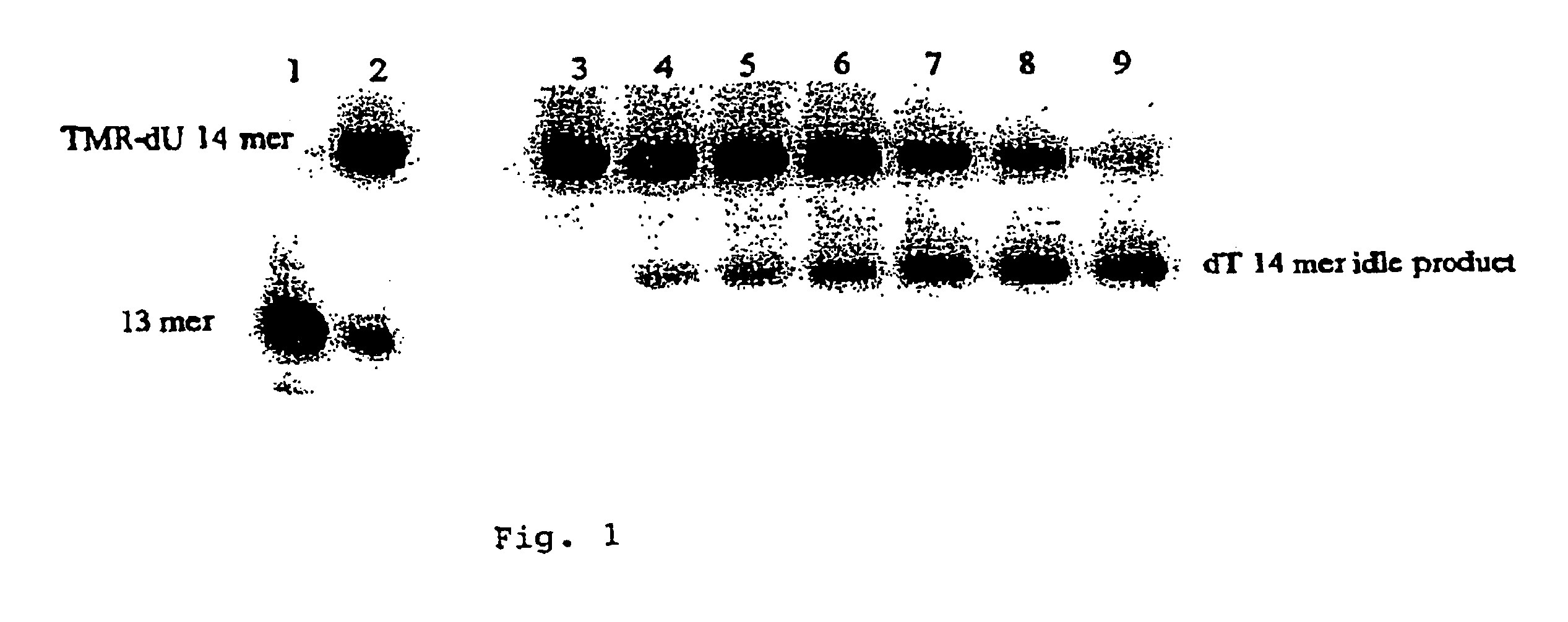Polynucleotide sequencing
a technology of polynucleotide and sequencing method, which is applied in the direction of sugar derivatives, biochemistry apparatus and processes, biochemistry apparatus, etc., can solve the problems of time-consuming and labor-intensive removal of blocking groups in this manner, and achieve high efficiency and time-saving
Inactive Publication Date: 2004-12-21
SOLEXA
View PDF4 Cites 1397 Cited by
- Summary
- Abstract
- Description
- Claims
- Application Information
AI Technical Summary
Benefits of technology
"The invention is a method for determining the sequence of polynucleotides using a polymerase enzyme and a complementary strand. The method involves immobilizing the polynucleotides on a solid support and detecting the incorporation of labeled bases. The method can be carried out on both single molecule and multi-molecule arrays. The use of single molecule arrays allows for spatially addressable sequencing, while the use of multi-molecule arrays allows for the resolution of individual molecules. The method makes use of the polymerase reaction and the conditions necessary for its occurrence, such as temperature, pH, and buffer compositions. The use of a fluorescent moiety as a label allows for the detection of incorporation events."
Problems solved by technology
However, the need to remove the blocking groups in this manner is time-consuming and must be performed with high efficiency.
Method used
the structure of the environmentally friendly knitted fabric provided by the present invention; figure 2 Flow chart of the yarn wrapping machine for environmentally friendly knitted fabrics and storage devices; image 3 Is the parameter map of the yarn covering machine
View moreImage
Smart Image Click on the blue labels to locate them in the text.
Smart ImageViewing Examples
Examples
Experimental program
Comparison scheme
Effect test
example
A 20 mer target polynucleotide (SEQ ID NO. 2) and a suitable (13 mer) primer molecule (SEQ ID NO. 3) were used having the sequences:
the structure of the environmentally friendly knitted fabric provided by the present invention; figure 2 Flow chart of the yarn wrapping machine for environmentally friendly knitted fabrics and storage devices; image 3 Is the parameter map of the yarn covering machine
Login to View More PUM
| Property | Measurement | Unit |
|---|---|---|
| diameter | aaaaa | aaaaa |
| distance | aaaaa | aaaaa |
| distance | aaaaa | aaaaa |
Login to View More
Abstract
The invention relates to the sequencing of a target polynucleotide sequence, immobilized on a solid support, using the polymerase reaction to extend a suitable primer and characterizing the sequential addition of labelled bases. The present invention further relates to the presence of a polymerase enzyme that retains a 3' to 5' exonuclease function, which is induced to remove an incorporated labelled base after detection of incorporation. A corresponding non-labelled base may then be incorporated into the complementary strand to allow further sequence determinations to be made. Repeating the procedure allows the sequence of the complement to be identified, and thereby the target sequence.
Description
This invention relates to the sequencing of polynucleotides. In particular, this invention discloses methods for determining the sequence of polynucleotides arrayed on a solid support.BACKGROUND TO THE INVENTIONAdvances in the study of molecules have been led, in part, by improvement in technologies used to characterize the molecules or their biological reactions. In particular, the study of the nucleic acids DNA and RNA has benefited from developing technologies used for sequence analysis and the study of hybridization events.An example of the technologies that have improved the study of nucleic acids, is the development of fabricated arrays of immobilized nucleic acids. These arrays consist typically of a high-density matrix of polynucleotides immobilized onto a solid support material. Fodor et al, Trends in Biotechnology (1994) 12:19-26, describes ways of assembling the nucleic acids using a chemically sensitized glass surface protected by a mask, but exposed at defined areas to ...
Claims
the structure of the environmentally friendly knitted fabric provided by the present invention; figure 2 Flow chart of the yarn wrapping machine for environmentally friendly knitted fabrics and storage devices; image 3 Is the parameter map of the yarn covering machine
Login to View More Application Information
Patent Timeline
 Login to View More
Login to View More Patent Type & Authority Patents(United States)
IPC IPC(8): C12Q1/68
CPCC12Q1/6869C12Q1/6823C12Q2521/319
Inventor BALASUBRAMANIAN, SHANKAR
Owner SOLEXA
Features
- R&D
- Intellectual Property
- Life Sciences
- Materials
- Tech Scout
Why Patsnap Eureka
- Unparalleled Data Quality
- Higher Quality Content
- 60% Fewer Hallucinations
Social media
Patsnap Eureka Blog
Learn More Browse by: Latest US Patents, China's latest patents, Technical Efficacy Thesaurus, Application Domain, Technology Topic, Popular Technical Reports.
© 2025 PatSnap. All rights reserved.Legal|Privacy policy|Modern Slavery Act Transparency Statement|Sitemap|About US| Contact US: help@patsnap.com

